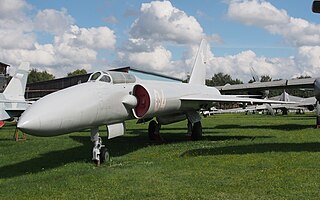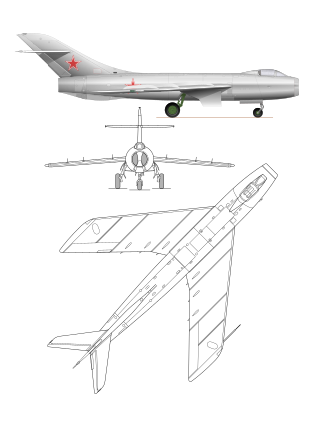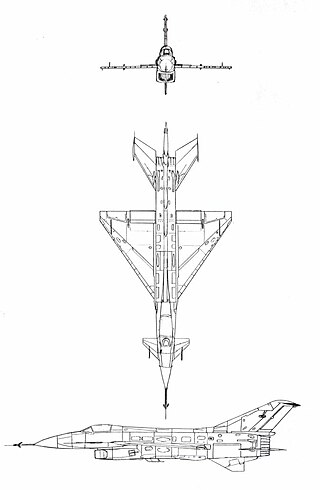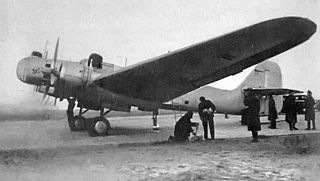
The Sukhoi Su-2 is a Soviet reconnaissance and light bomber aircraft used in the early stages of World War II. It was the first airplane designed by Pavel Sukhoi. The basic design received an engine and armament upgrade (Su-4) and was modified for the ground-attack role (ShB).

The Sukhoi Su-7 is a swept wing, supersonic fighter aircraft developed by the Soviet Union in 1955. Originally, it was designed as a tactical, low-level dogfighter, but was not successful in this role. On the other hand, the soon-introduced Su-7B series became the main Soviet fighter-bomber and ground-attack aircraft of the 1960s. The Su-7 was rugged in its simplicity, but its Lyulka AL-7 engine had such high fuel consumption that it seriously limited the aircraft's payload, as even short-range missions required that at least two hardpoints be used to carry drop tanks rather than ordnance.

The Douglas X-3 Stiletto is a 1950s United States experimental jet aircraft with a slender fuselage and a long tapered nose, manufactured by the Douglas Aircraft Company. Its primary mission was to investigate the design features of an aircraft suitable for sustained supersonic speeds, which included the first use of titanium in major airframe components. Douglas designed the X-3 with the goal of a maximum speed of approximately 2,000 mph (3,200 km/h), but it was seriously underpowered for this purpose and could not even exceed Mach 1 in level flight. Although the research aircraft was a disappointment, Lockheed designers used data from the X-3 tests for the Lockheed F-104 Starfighter which used a similar trapezoidal wing design in a successful Mach 2 fighter.

The Sukhoi Su-11 is an interceptor aircraft used by the Soviet Union during the Cold War.

The Mikoyan-Gurevich MiG-105, part of the Spiral program, was a crewed test vehicle to explore low-speed handling and landing. It was a visible result of a Soviet project to create an orbital spaceplane. The MiG 105 was nicknamed "Lapot", for the shape of its nose.

The Sukhoi Su-9 is a single-engine, all-weather, missile-armed interceptor aircraft developed by the Soviet Union.

The Yakovlev Yak-27 is a family of Soviet supersonic aircraft developed in 1958 from the Yak-121 prototype. The most built variant was the tactical reconnaissance Yak-27R.

The Ilyushin DB-3, where "DB" stands for Dalniy Bombardirovshchik meaning "long-range bomber", is a Soviet bomber aircraft of World War II. It was a twin-engined, low-wing monoplane that first flew in 1935. 1,528 were built. The DB-3 was the precursor of the Ilyushin Il-4.

The Myasishchev M-50 is a Soviet prototype four-jet engine supersonic strategic bomber which never attained service. Only one flightworthy prototype was built, which was first flown in October 1959. The M-50 was constructed by the Myasishchev design bureau.

The Ilyushin Il-6 was a Soviet long-range bomber developed from the Ilyushin Il-4 during 1942. Originally intended as a high-speed replacement for the Il-4, it was recast as a very long-range bomber with fuel-conserving diesel engines before production of the single prototype began in December 1942. Flight testing showed controllability issues when landing at high weights and the engines proved to be hard to start at low temperatures and were slow to respond to throttle movements. Further development was canceled in 1944.

The Lavochkin La-250 "Anakonda" was a high-altitude interceptor aircraft prototype developed in the Soviet Union by the Lavochkin design bureau in the 1950s. Its nickname "Anaconda" was invented during the flight test and referred to both the elongated body shape as well as the relatively critical flight characteristics of the machine.

The Ilyushin Il-102 is a Soviet experimental jet-powered ground-attack aircraft designed by Ilyushin. This aircraft was never chosen for production, being surpassed by the Su-25. Only a few development prototypes were built.

The Sukhoi Su-6 was a Soviet ground-attack aircraft developed during World War II. The mixed-power high-altitude interceptor Su-7 was based on the single-seat Su-6 prototype.
The Sukhoi Su-8 or DDBSh was a Soviet prototype ground-attack aircraft of World War II.

The Sukhoi Su-15 was a prototype Soviet all-weather interceptor which never reached production.

The Sukhoi Su-17 was a prototype Soviet fighter. The name was later reused for an entirely different fighter-bomber, see Sukhoi Su-17.

The Mikoyan-Gurevich Ye-8 was a supersonic jet fighter developed in the Soviet Union, intended to replace the MiG-21. Only two prototypes were built in 1960–61. The original MiG-21's air intakes were moved under the fuselage, freeing up the nose where a larger and more powerful radar, able to deliver longer range air-to-air missiles, could be built in. Canards were built to both sides of the nose, in front of the cockpit,.

The Tupolev ANT-37 was a Soviet twin-engined long-range bomber designed and built by the Tupolev design bureau, the design team operating under the guidance of Pavel Sukhoi. The aircraft did not enter production, but three examples of the type were used for research and record breaking flights.
The Mikoyan-Gurevich I-75 was the final design of a series of three experimental swept-wing interceptors developed in the Soviet Union in the mid-late 1950s by the Mikoyan-Gurevich design bureau from their Mikoyan-Gurevich I-3 airframe. All the aircraft in the I-3 program were affected by delays in the development of the Klimov VK-3 turbojet engine, its cancellation and ultimate replacement by the Lyulka AL-7F turbojet engine.
The Ilyushin DB-4 or TsKB-56 was a Soviet twin-engined bomber aircraft of the early 1940s. It was a development of the Ilyushin DB-3 and was intended as a replacement for the earlier aircraft, but only two prototypes were built; engine problems and the need to concentrate production on existing types following the German invasion of the Soviet Union in June 1941 meant that no more examples were built.



















